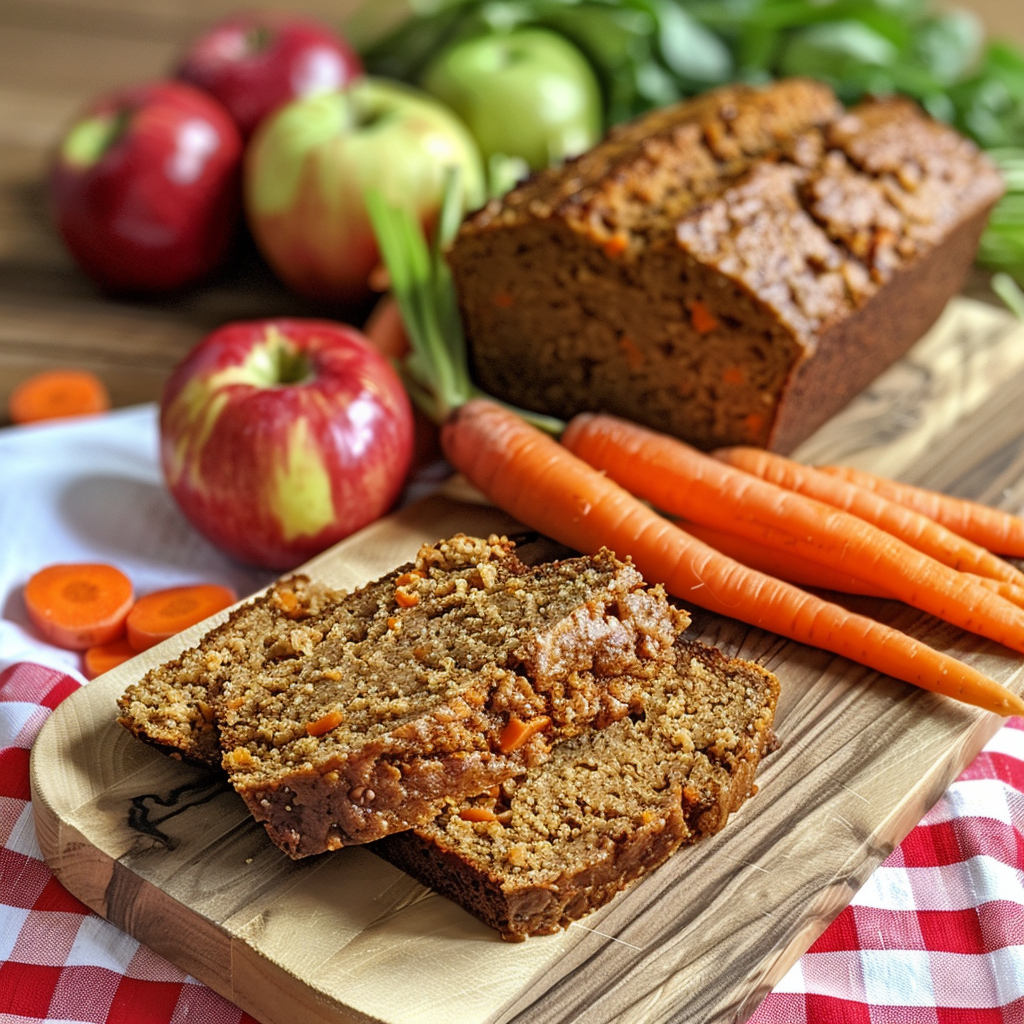Gluten-Free Carrot Loaf with Almond & Coconut Flour

Share
Adding a Healthy Twist with Almond and Coconut Flours
As someone who’s always looking for delicious recipes that accommodate the dietary needs of my friends and family, I’ve come to appreciate the versatility of alternative flours like almond and coconut flour. This Carrot Loaf recipe has become a favorite in my kitchen, especially because I know a few people who are diabetic and appreciate a treat that’s both delicious and mindful of their health needs. The combination of almond and coconut flours not only makes this loaf gluten-free but also adds a rich, nutty flavor that pairs beautifully with the sweetness of the carrots. I love that this recipe allows me to create something that everyone can enjoy, without compromising on taste or texture. Plus, it’s a bonus knowing that it’s a healthier option that I can feel good about serving.
Did You Know?
Carrots are not only great for your vision but also rich in beta-carotene, which your body converts into vitamin A. This essential nutrient supports immune function, skin health, and more. Fun fact: Carrots were originally purple or white; the orange variety we know today was cultivated by Dutch farmers in the 17th century.
Yield: 12 slices
Ingredients:
- 1 1/2 cups almond flour
- 1/2 cup coconut flour
- 1 teaspoon baking soda
- 1/2 teaspoon baking powder
- 1 teaspoon ground cinnamon
- 1/2 teaspoon ground nutmeg (optional)
- 1/4 teaspoon salt
- 3 large eggs
- 1/4 cup coconut oil, melted
- 1/4 cup maple syrup (or sugar-free alternative)
- 1 teaspoon vanilla extract
- 1 1/2 cups grated carrots
- 1/4 cup unsweetened applesauce
- 1/2 cup chopped walnuts (optional)
Instructions:
Personal Tip: When using alternative flours, like almond and coconut flour, be aware that they absorb more moisture than traditional flours, which is why it's important to balance the liquid ingredients.
-
Preheat Oven:
Personal Tip: Always start with a preheated oven to ensure even baking.
Preheat to 350°F (175°C). Grease or line a loaf pan with parchment paper. -
Mix Dry Ingredients:
Personal Tip: Sifting the dry ingredients together helps to remove any lumps, especially with almond flour, which can sometimes clump.
In a large bowl, combine almond flour, coconut flour, baking soda, baking powder, cinnamon, nutmeg (if using), and salt. -
Mix Wet Ingredients:
Personal Tip: Ensure the coconut oil is melted but not hot when mixing with eggs to avoid cooking the eggs.
In another bowl, whisk together eggs, melted coconut oil, maple syrup, vanilla extract, grated carrots, and applesauce. -
Combine:
Personal Tip: Fold the dry ingredients into the wet mixture gently to avoid overmixing, which can make the loaf dense.
Stir the dry ingredients into the wet ingredients until just combined. Fold in chopped walnuts if using. -
Bake:
Personal Tip: Keep an eye on the loaf as it bakes—if the top browns too quickly, cover it with foil to prevent burning.
Pour the batter into the prepared loaf pan. Bake for 45-50 minutes, or until a toothpick inserted into the center comes out clean. -
Cool:
Personal Tip: Allow the loaf to cool completely before slicing for cleaner cuts and better texture.
Let the loaf cool in the pan for 10 minutes, then transfer it to a wire rack to cool completely.
Nutritional Information (Per Slice):
Calories, 200, Protein, 5g, Carbohydrates, 15g, Fiber, 5g, Net Carbohydrates, 10g, Fat, 15g, Saturated Fat, 5g, Cholesterol, 35mg, Sodium, 150mg, Sugars, 7g, Glycemic Index, Low
Kitchen Tips, Great Ideas, How to Save Money
-
Using Fresh Carrots: Freshly grated carrots offer the best texture and flavor for your loaf. Pre-grated carrots can be dry and lack the moisture needed for a perfect bake.
-
Bulk Buying: Purchase almond flour, coconut flour, and nuts in bulk to save money. These ingredients have a long shelf life and can be used in various recipes.
-
Homemade Applesauce: Making your own unsweetened applesauce is easy and cost-effective. Simply peel, core, and cook apples until soft, then blend until smooth.
-
Seasonal Spices: Use seasonal spices like cinnamon and nutmeg to enhance the flavor of your loaf. Buying spices in bulk can also save money and ensure you always have them on hand.
-
Greasing the Pan: Use a non-stick spray or line your loaf pan with parchment paper to prevent sticking and ensure easy removal of the loaf.
-
Storage Tips: Store leftover carrot loaf in an airtight container at room temperature for up to 3 days or in the refrigerator for up to a week. You can also freeze slices for longer storage.
-
Flavor Variations: Add a handful of raisins or dried cranberries for a sweet twist. You can also mix in some shredded coconut for extra texture and flavor.
-
Reducing Food Waste: Use any leftover grated carrots in salads, soups, or stir-fries. They can also be added to smoothies for an extra boost of nutrition.
-
Nutritional Boost: Substitute part of the almond flour with ground flaxseed or chia seeds for added fiber and omega-3 fatty acids.
-
Cost-Saving Tips: Look for sales and discounts on baking supplies. Buying store-brand ingredients can also cut costs without sacrificing quality.
Why It’s Important to Understand the Difference in Flours
Understanding the difference between traditional flours and alternatives like almond and coconut flour is key to successful baking, especially for those with dietary restrictions. Almond flour is high in protein and healthy fats, making it a good choice for those following low-carb or ketogenic diets. Coconut flour, on the other hand, is very absorbent and requires more liquid than regular flour. It’s also high in fiber, which makes baked goods more filling and nutritious. By combining these flours, you not only create a gluten-free product but also one that offers a unique texture and flavor profile, ensuring that everyone, regardless of dietary needs, can enjoy a delicious treat.


